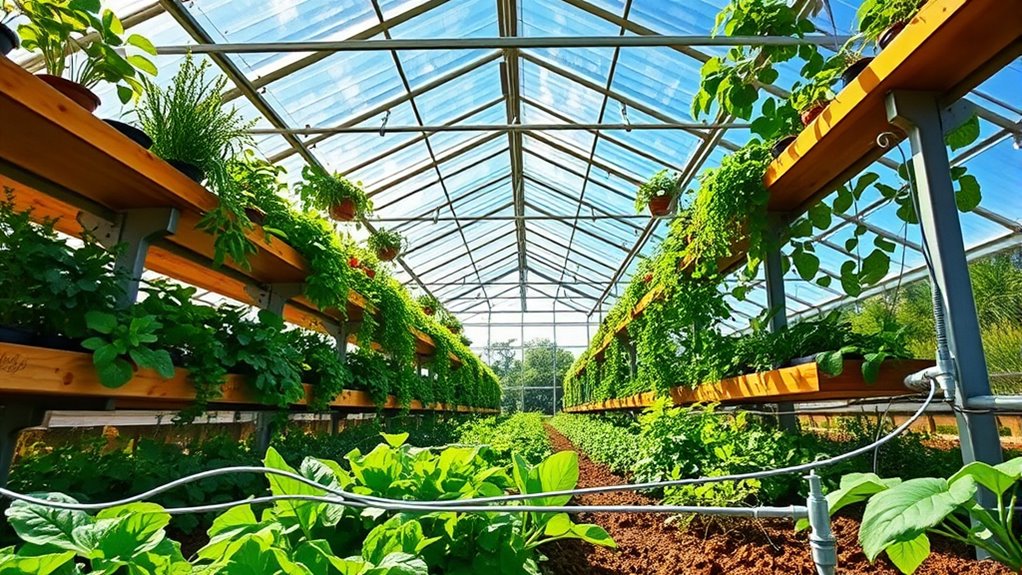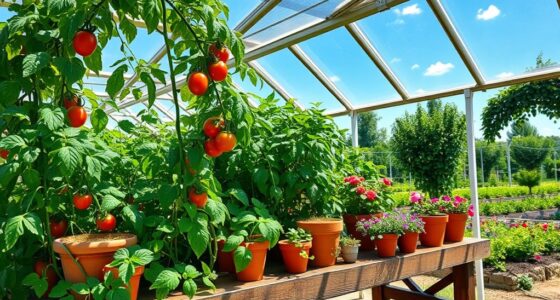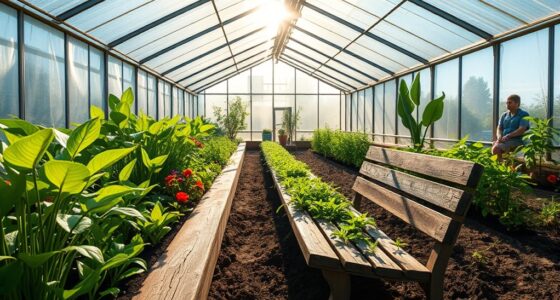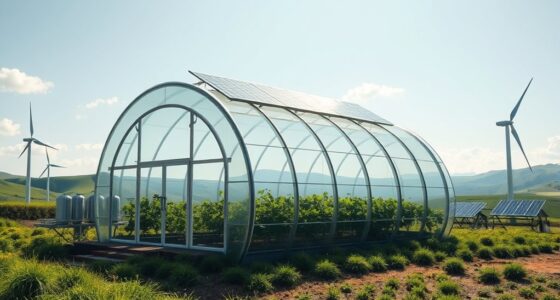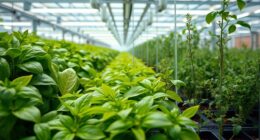You'll find numerous inspiring case studies showcasing sustainable greenhouses that blend innovative techniques and renewable energy. For example, the Aurora Anguilla Resort uses hydroponic systems to grow food efficiently while minimizing energy consumption. In Trinidad & Tobago, Berrycove Ltd. employs climate-smart designs to withstand severe weather. Additionally, Vermont Herb and Salad Company relies on log wood gasification for heat. These examples highlight how sustainability is reshaping agriculture, and you'll discover even more remarkable initiatives ahead.
Key Takeaways
- Aurora Anguilla's hydroponic greenhouses utilize solar energy and climate control features for sustainable local food production and resilience against cyclonic winds.
- Berrycove Ltd. in Trinidad & Tobago employs advanced hydroponic systems and resilient greenhouse designs to enhance food security and withstand extreme weather conditions.
- Ladakh's passive solar greenhouses leverage ground heat and renewable energy, resulting in significant off-season yields and government-supported community job creation.
- Grōv Fodder Production Facility reduces environmental impact through advanced waste minimization methods and personalized animal nutrition while integrating renewable energy sources.
- Vermont Herb and Salad Company uses log wood gasification for efficient heating, significantly cutting energy costs and utilizing locally sourced biomass for sustainability.
Aurora Anguilla Resort & Golf Club: Climate Control and Local Food Production
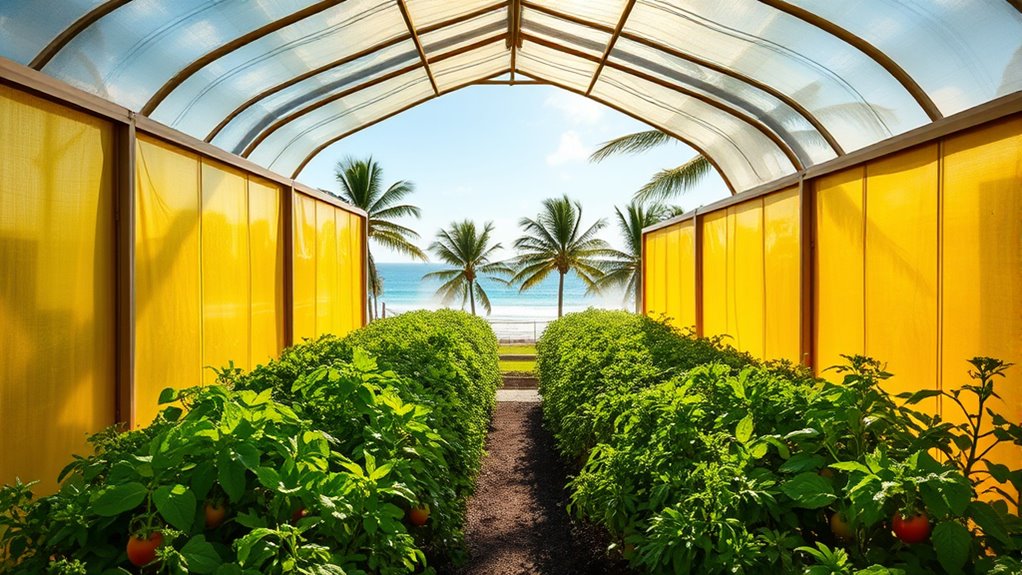
At Aurora Anguilla Resort & Golf Club, the integration of climate control features and local food production sets a new standard for sustainability.
The resort boasts two hydroponic greenhouses, utilizing natural light to enhance plant growth while minimizing energy use. These structures are resilient to cyclonic winds and flooding, ensuring continuous operation even during harsh weather. Additionally, the resort features an 18-hole course recognized as one of the most challenging finishing holes in the Caribbean. Moreover, the use of solar energy to power the greenhouses further reduces their carbon footprint and operational costs. Incorporating solar charge controllers into their systems optimizes energy harvest, enhancing overall efficiency. This aligns with the principles of emergency preparedness essentials, ensuring that the resort can effectively respond to potential crises.
The resort features resilient hydroponic greenhouses that harness natural light for efficient, year-round food production.
By growing its own produce on-site, the resort boosts food security and reduces reliance on suppliers, providing guests with fresher, higher-quality meals. This commitment to local food production aligns with sustainability goals, reducing carbon footprints and conserving water.
Additionally, the advanced hydroponic systems allow for year-round crop growth, diversifying options for culinary experiences and enhancing guest satisfaction.
Berrycove Ltd. in Trinidad & Tobago: Climate-Smart Greenhouse Innovations
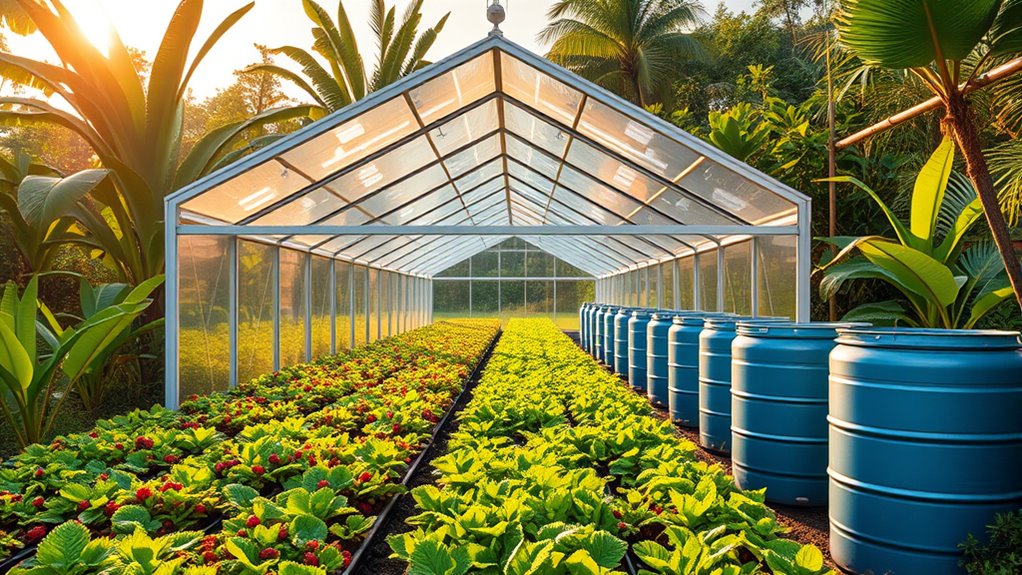
Located in Tobago's Cove Estate, Berrycove Ltd. is transforming the agricultural landscape with its climate-smart greenhouse innovations.
By utilizing advanced hydroponic systems across its 12-acre farm, you'll find efficient crop production that enhances food security and reduces reliance on imports. This initiative primarily focuses on enhancing food security through local produce. Additionally, this approach supports sustainable habits that enhance overall well-being. Healthy ecosystems provide essential services such as clean air and water purification, which are vital for a thriving agricultural environment. The implementation of backyard greenhouses can significantly support home gardeners in extending their growing seasons.
The greenhouses are designed to withstand Category 5 hurricanes, ensuring resilience against extreme weather.
With features like rainwater collection, precise temperature control, and effective cross-ventilation, Berrycove optimizes growing conditions.
Their partnership with local educational institutions fosters knowledge sharing, while plans for expansion and an agro-processing facility promise job creation and economic growth.
Passive Solar Greenhouses in Ladakh: Off-Season Vegetable Production
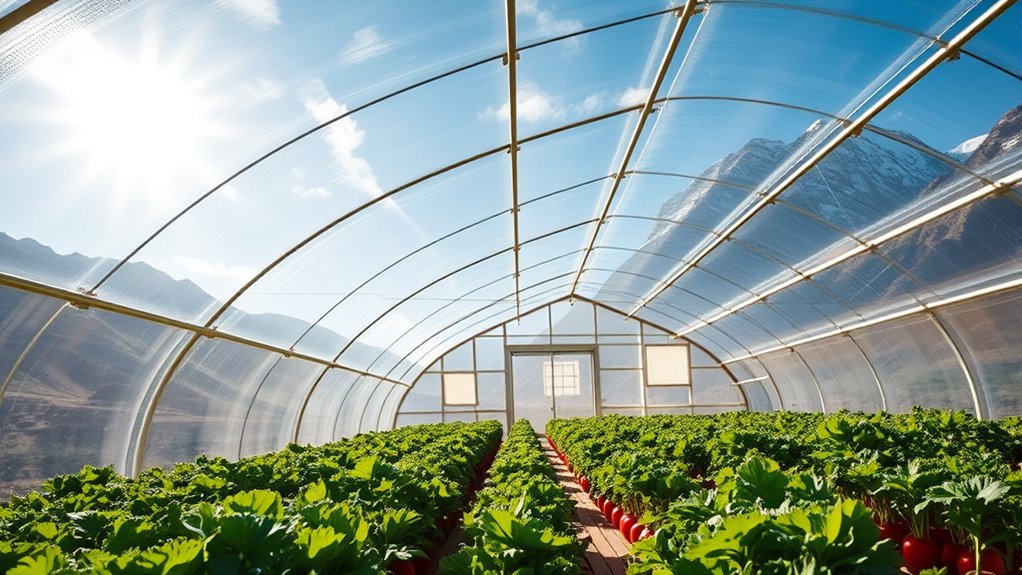
While many regions struggle with extreme temperatures, Ladakh's passive solar greenhouses offer a solution for off-season vegetable production.
These structures utilize triple-layer polycarbonate sheets for insulation and stone walls to absorb and release heat, optimizing thermal mass. Built three feet below ground, they harness ground heat effectively. Additionally, these greenhouses can yield significant amounts of produce, allowing farmers to grow temperature-sensitive crops even in harsh winter conditions. Geothermal systems can achieve efficiency ratings that further contribute to sustainable agricultural practices. Incorporating lighting design in these structures enhances the growth conditions for various crops. Moreover, the use of renewable energy sources like solar power in these greenhouses can further reduce their environmental impact.
Ventilation systems help regulate summer temperatures, ensuring energy efficiency without external heating. By growing locally, farmers reduce their carbon footprint and boost food security, providing fresh produce year-round.
With a 75% government subsidy, these greenhouses enhance income opportunities and create jobs in the community. The initiative not only empowers farmers but also aims to establish 1,000 greenhouses in two years, showcasing a sustainable approach to agriculture in challenging climates.
Grōv Fodder Production Facility: Sustainable Animal Feed Solutions
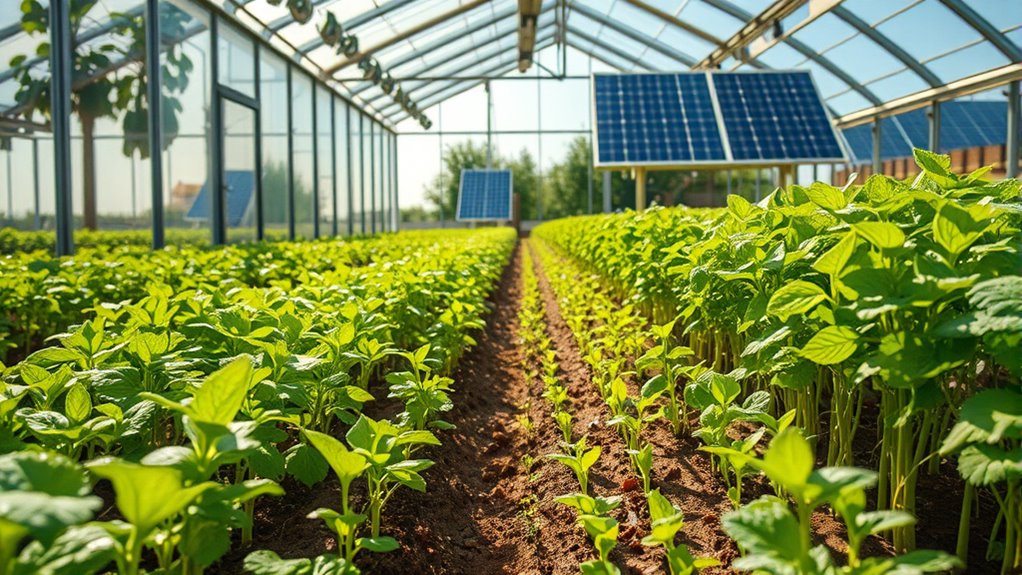
As demand for sustainable animal feed solutions grows, the Grōv Fodder Production Facility stands at the forefront, leveraging innovative technologies to transform the way animal feed is produced.
By utilizing advanced methods, the facility reduces its environmental footprint through locally sourced materials and waste minimization. You'll appreciate how Grōv emphasizes personalized nutrition, using genomics and AI to enhance animal health. Industrial agriculture's impact on biodiversity is a critical consideration in their approach, as they focus on creating sustainable practices that benefit the environment. Additionally, their heat pump systems help to improve air quality within the facility, ensuring a healthier environment for both animals and workers. Incorporating protein-packed seeds into their feed formulations further enhances nutritional value and sustainability. Furthermore, the facility's commitment to resource efficiency aligns with broader sustainability goals.
Grōv prioritizes sustainability with local materials and innovative techniques, enhancing animal health through personalized nutrition and advanced technology.
Resource efficiency is key, cutting down land and water usage considerably. The integration of renewable energy sources aligns with broader sustainability goals, while artificial intelligence optimizes feed formulations for better performance.
Additionally, recycling food waste and employing efficient processing techniques promote sustainability and improve economic viability. Grōv truly exemplifies the future of sustainable animal feed production.
West Island College Greenhouse: Educational Impact and Innovation

The West Island College Greenhouse stands as a beacon of educational innovation, drawing inspiration from the principles of sustainability seen in facilities like the Grōv Fodder Production Facility.
This greenhouse enhances your curriculum by integrating theoretical learning with hands-on experiences, allowing you to explore biology, chemistry, and environmental science in an interdisciplinary manner. Well-rounded education is emphasized through this innovative approach, ensuring that students develop a holistic understanding of the subject matter. Additionally, understanding watering techniques for plants is crucial for successful greenhouse management. Moreover, the integration of sustainable practices in greenhouse operations helps students learn about the importance of reducing waste and conserving resources. The design of the greenhouse incorporates passive solar heating, which maximizes energy efficiency and supports year-round growing.
With state-of-the-art equipment and collaborative spaces, it fosters teamwork and creativity, preparing you for careers in environmental fields.
You'll engage in sustainability practices, helping to reduce the college's carbon footprint and promote local biodiversity.
Through community outreach, you'll also develop empathy for the environment while honing practical skills in gardening and environmental management, contributing to your personal growth and development.
Cate Farm: Biodiesel Heating for Sustainable Greenhouses
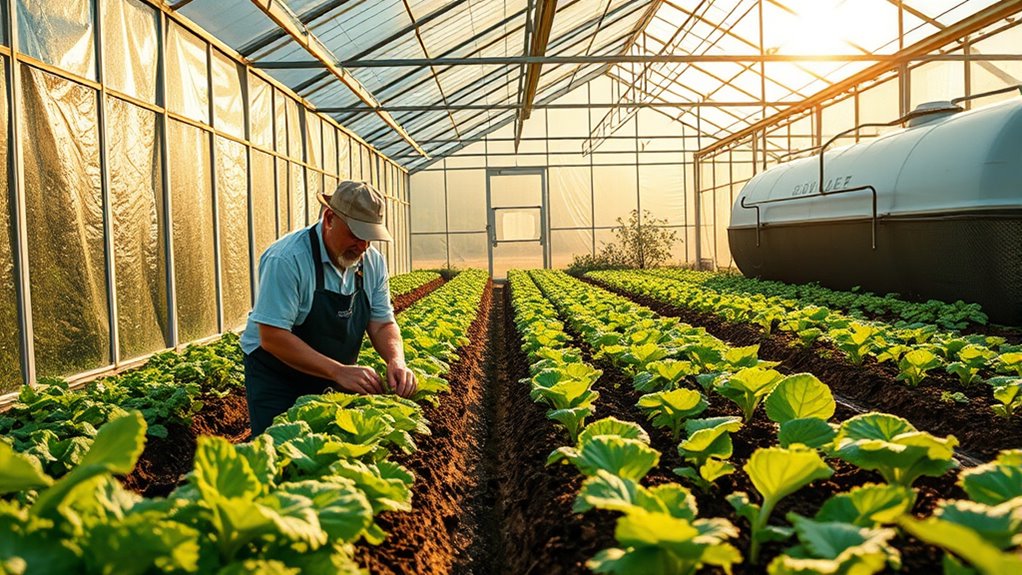
Cate Farm in East Montpelier, Vermont, showcases an innovative approach to sustainability by using biodiesel for heating its greenhouses.
This farm operates seven greenhouses, producing a variety of vegetables, herbs, and flowers. By converting waste vegetable oil into biodiesel, Cate Farm reduces its reliance on fossil fuels and saves around $4,000 annually compared to traditional heating oil. The use of energy-efficient models also aligns with their commitment to sustainability, helping to further reduce heating costs. Additionally, the farm's practice of sourcing biodiesel locally supports renewable resources and minimizes transportation emissions, enhancing their overall eco-friendliness. Furthermore, the adoption of green technologies not only lowers operating costs but also contributes positively to the local economy.
The biodiesel production process involves using methanol and sodium hydroxide, with careful adjustments to existing equipment ensuring efficient use. Greenhouse efficiency is a key consideration in their operations, as they strive to enhance both productivity and sustainability.
You'll find that biodiesel is stored in a minimally heated shed, and seasonal practices maximize its effectiveness. This commitment not only enhances operational efficiency but also greatly contributes to environmental sustainability, making Cate Farm a model for green greenhouse practices.
Vermont Herb and Salad Company: Log Wood Gasification Heating

Located in Benson, Vermont, the Vermont Herb and Salad Company employs log wood gasification for its greenhouse heating, showcasing another innovative approach to sustainable agriculture. This system converts wood into gas, offering a cleaner and more efficient way to generate heat compared to traditional methods. By relying on locally sourced biomass, you reduce transportation costs and lower your carbon footprint. Additionally, this method aligns with model evaluation metrics used in sustainable practices, ensuring that agricultural systems remain effective and environmentally friendly. The log wood gasification setup includes a gasifier, heat exchanger, and boiler, ensuring reliable heating for your greenhouse. Regular maintenance keeps the system running effectively, while the use of well-seasoned wood enhances efficiency. Furthermore, this method can significantly reduce energy bills for greenhouse operations, leading to long-term financial savings. This method not only cuts heating costs but also aligns with sustainable practices, making it a model for environmentally conscious growers. The use of biomass for heating supports renewable energy sources, contributing to a more sustainable agricultural landscape. Moreover, utilizing wood as a renewable resource ensures a consistent and eco-friendly fuel supply for ongoing operations.
Butterworks Farm: Harnessing Wind Power for Greenhouse Operations

At Butterworks Farm in Westfield, Vermont, wind power plays a crucial role in sustainable greenhouse operations. The farm utilizes a 35 kW wind generator, producing 3,000-3,500 kWh monthly, which covers 50-60% of its winter electricity needs. This renewable energy source supports the farm's commitment to sustainability and carbon sequestration, as it integrates organic practices with 100% grass-fed dairy operations. Additionally, the use of wind energy contributes to reducing carbon emissions, further enhancing the farm's ecological impact. The farm's commitment to sustainability is also reflected in its use of chia seeds, known for their numerous health benefits and ability to support gut microbiota. Despite challenges like system shutdowns during high winds, ideal conditions between 15-20 mph allow for efficient energy production. Effective energy solutions like this can significantly reduce tax implications for agricultural operations, ensuring better financial sustainability.
Frequently Asked Questions
How Much Initial Investment Is Required for Sustainable Greenhouse Projects?
For sustainable greenhouse projects, your initial investment can vary widely. A DIY setup might cost around $1,000, while professional builds typically range from $2,000 to $25,000, averaging about $11,000.
Factors like size, materials, and necessary equipment greatly influence costs. If you opt for advanced climate control systems or energy-efficient technologies, your expenses will increase, but they can lead to savings in the long run.
Planning and budgeting are essential to manage these costs effectively.
What Are the Maintenance Costs Associated With Sustainable Greenhouses?
Maintenance costs for sustainable greenhouses can feel overwhelming, yet they're essential for long-term success.
You'll face energy consumption expenses, usually between $18,000 and $60,000 annually, alongside regular system maintenance.
While labor costs can add up, automation helps reduce them.
Consider preventive measures; proactive maintenance can save you from costly repairs later.
Investing in high-quality materials now means fewer headaches down the line, making it a wise choice for your greenhouse's future.
Can Sustainable Greenhouses Operate in Urban Areas Effectively?
Yes, sustainable greenhouses can operate effectively in urban areas. They utilize limited space efficiently, providing fresh produce year-round while enhancing air quality and energy efficiency.
You'll find they also promote community engagement and biodiversity. By implementing smart management systems, these greenhouses reduce water and energy use, making them viable options for urban agriculture.
With the right planning, you can enjoy the economic and environmental benefits they offer in your city.
What Types of Crops Are Best Suited for These Greenhouses?
Imagine a lush Eden right in your backyard. For your greenhouse, leafy greens like lettuce and kale thrive in winter's chill, while tomatoes and cucumbers bask in the summer sun.
Year-round, microgreens and Swiss chard keep your table vibrant. If you're feeling adventurous, why not try cucamelons or tea plants?
With the right care, your greenhouse can become a thriving sanctuary for a diverse array of crops, bringing fresh flavors to your kitchen.
How Do Sustainable Greenhouses Impact Local Biodiversity?
Sustainable greenhouses substantially impact local biodiversity in various ways.
They create habitats for urban wildlife, support pollinators, and promote diverse plant species, all of which enhance the local ecosystem.
By incorporating green walls and facades, these structures provide refuge for birds and beneficial insects.
You'll notice that such greenhouses contribute to urban green spaces, fostering ecological corridors that allow species movement and ultimately enrich the biodiversity within densely populated areas.
Conclusion
In a world where we often overlook the beauty of sustainability, these greenhouses remind us that growing food doesn't have to damage the planet. Who knew that climate control and local food production could go hand in hand? It's almost amusing how the very places that seem like simple structures are actually powerhouses of innovation and environmental stewardship. So, here's to our future, where greenhouses aren't just about plants, but about nurturing our planet too.
